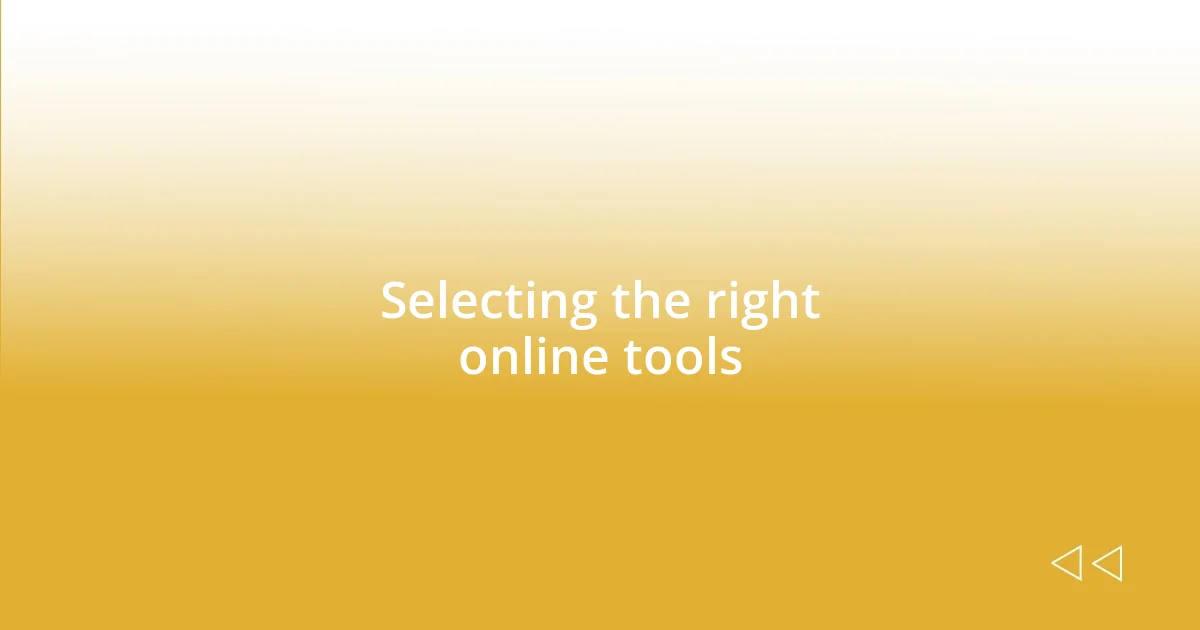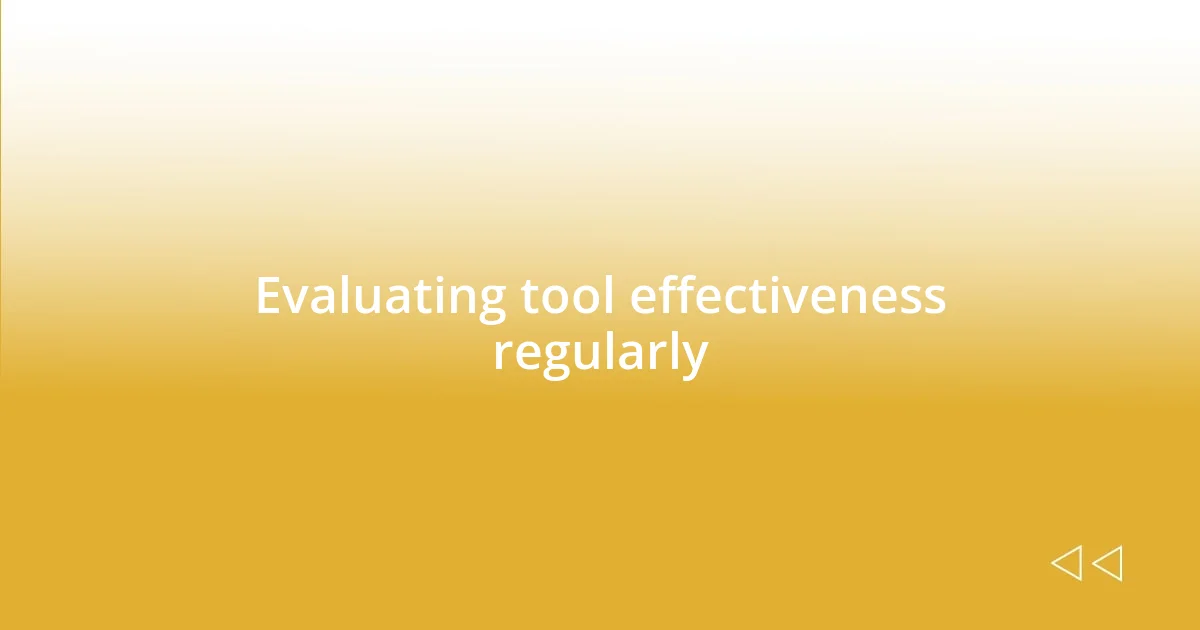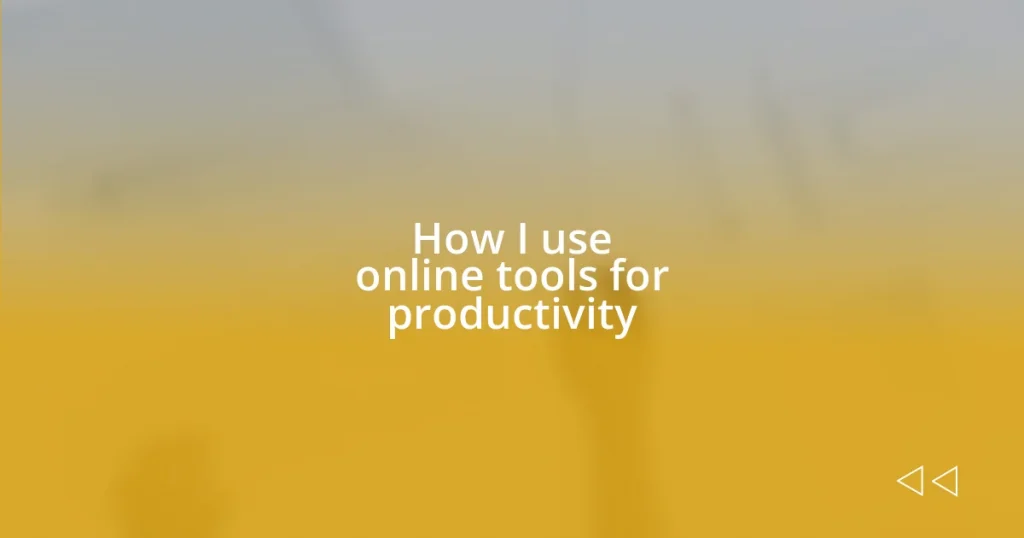Key takeaways:
- Identifying specific productivity needs aids in selecting the right tools, streamlining workflows effectively.
- Utilizing digital planners enhances task organization and prioritization, leading to improved focus and motivation.
- Regular evaluation of productivity tools is essential to ensure they meet evolving needs and enhance overall productivity.

Understanding productivity tools
Productivity tools are like the silent partners in our workflow; they streamline tasks, enhance organization, and ultimately help us achieve our goals. I remember when I first started using a task manager app. Initially, it felt overwhelming, but soon, I realized how it transformed my chaotic to-do list into manageable steps. Have you ever felt buried under a mountain of tasks? That feeling can vanish when you effectively use the right tools.
From my experience, different tools serve various purposes. For instance, a calendar app is invaluable for scheduling and time-blocking, while note-taking apps help me capture fleeting ideas in an organized manner. I still chuckle at the time I tried to manage everything in my head. It was a disaster—like trying to juggle while riding a unicycle! Finding the right balance of tools tailored to your needs can make all the difference.
The beauty of productivity tools lies in their adaptability. Whether you’re a visual learner who thrives in mind mapping or a list-maker who craves structure, there’s something out there for you. I often experiment with new tools, and I’ve found that keeping an open mind can lead to those delightful “aha!” moments. So, what tools resonate with you, and how do they align with your personal goals?

Identifying your productivity needs
To truly enhance your productivity, the first step is identifying what exactly you need from an online tool. I remember grappling with vague goals at first; I thought a single tool could do everything for me. But, as I honed in on specific challenges—like managing my time better or organizing my projects—it became clearer that different tools serve different purposes. Clarifying your needs not only refines your tool selection but also creates a more robust structure for your workflow.
Here’s a quick list to pinpoint your productivity needs:
- Task Management: Do you struggle to keep track of tasks and deadlines?
- Time Tracking: Are you finding it hard to allocate enough time for important projects?
- Collaboration: Do you work with a team that requires shared resources and communication?
- Idea Capture: Do you often have thoughts or ideas that slip away due to a lack of a consistent way to record them?
- Organization: Is clutter, either digital or physical, holding you back from being productive?
By clearly defining your needs, you set the stage for choosing the right productivity tools that align with your unique workflow. I’ve seen firsthand how this clarity can lead to meaningful progress.

Selecting the right online tools
Selecting the right online tools can feel daunting, especially with so many options available. I’ve found that a good place to start is by reflecting on my specific workflows. For example, when I switched to using a project management tool, it was a game-changer. Initially, I was skeptical about whether it would really make my life easier or just add another layer of complexity. But once I delved into its features, I discovered how seamlessly it integrated with my existing tasks and priorities. Have you ever underestimated the impact a focused tool can have on your productivity?
Beyond personal reflection, I focus on how a tool aligns with my overall goals. I remember trying out various note-taking apps, but it wasn’t until I discovered one that allowed me to tag and categorize my notes that I truly saw its value. It was like finding a comfortable pair of shoes that I could wear all day without any discomfort. Additionally, looking at user reviews and case studies can provide insights into how others have leveraged these tools effectively, leading to productivity breakthroughs. What about you? Have you ever relied on feedback from others to make a decision on a tool?
Ultimately, the tool should feel like an extension of yourself rather than a hindrance. This perspective reminds me of the time I invested in selecting a time-tracking app. The initial learning curve felt overwhelming, but over time, it became an essential part of my daily routine, helping me gain insights into how I spent my time. Choosing the right online tools is all about finding what clicks for you personally. As you evaluate your options, remember to be patient with the process of exploration.
| Criteria | Example Tools |
|---|---|
| Task Management | Todoist, Trello |
| Time Tracking | Toggle, Clockify |
| Collaboration | Slack, Asana |
| Idea Capture | Evernote, OneNote |
| Organization | Google Drive, Notion |

Organizing tasks with digital planners
Digital planners have completely transformed how I organize my tasks. When I first started using one, I felt a sense of clarity I hadn’t had before. I remember sitting down with my digital planner, mapping out my week, and savoring the satisfaction of visualizing my goals. Have you ever experienced that moment when everything just clicks into place? For me, it was life-changing.
One feature I particularly love is the ability to categorize tasks. I categorize them by urgency and type, which helps me prioritize effectively. As I fill in my planner each day, it’s like shifting from chaos to a well-choreographed dance. The visual layout keeps me motivated and allows me to see not just what I have to do, but also how my tasks align with my broader goals. It’s reassuring to see everything in one place, ensuring nothing slips through the cracks. How do you ensure that your tasks are well-organized?
Additionally, the reminders function is a lifesaver. I can schedule alerts for deadlines, meetings, or even self-care breaks. There’s something comforting about having that gentle nudge from my digital planner, like a friend reminding me to stay on track. I clearly recall a time when I nearly forgot an important appointment, but my planner sent me a timely alert, saving the day. Embracing these tools has greatly enhanced my productivity, allowing me to stay focused and organized like never before.

Collaborating with team members online
Collaborating online can truly redefine how teams work together. When I first started using platforms like Slack for communication, it felt like unlocking a new level of connectivity. Instead of waiting for emails that sometimes got lost in the shuffle, I could send quick messages or share files in real time. Have you ever felt the immediate benefit of knowing your teammates were just a click away?
One of my favorite experiences was during a critical project deadline when we needed to brainstorm ideas quickly. Using a shared document on Google Docs allowed us to collaborate effortlessly. Everyone could contribute simultaneously, which sparked creativity in a way I had never experienced before. Watching those ideas flow and evolve in real time made me realize just how powerful online collaboration tools can be. What’s your go-to method for fostering teamwork online?
I believe that establishing norms for online collaboration is crucial. Initially, our team struggled with miscommunication. Some members preferred a more casual tone, while others leaned towards formality. But after discussing our preferences openly, we set clear guidelines for how we communicate on platforms like Asana. This clarity significantly reduced misunderstandings and helped us feel more unified. Reflecting on my journey, it seems that open dialogue is the key to effective online collaboration. Have you found clarity in communication to be transformative for your team dynamics?

Tracking progress and results
Tracking progress is vital in any productivity journey, and I’ve found that utilizing online tools makes it not only easier but also more rewarding. For instance, I use apps like Trello to create visual boards that represent my tasks and their statuses. There’s a unique satisfaction in dragging tasks from “In Progress” to “Completed.” It’s almost like a mini-celebration every time I move something off my plate—don’t you love that feeling of accomplishment?
One tool I swear by is a time-tracking app. I remember a time when I underestimated how much time certain tasks took me. By logging my hours, I gained insights into my work habits that surprised me. It turned out I was spending far too much time on emails and not enough on key projects. Seeing this data in front of me was enlightening and propelled me to reassess my approach. Have you ever found yourself surprised by how your time is actually spent?
Finally, I rely on weekly review sessions. I block out a little time at the end of each week to analyze my progress and results. It’s not just about reviewing what I accomplished; I also reflect on what didn’t go as planned. This practice often leads to powerful realizations—for example, I noticed that I consistently underestimated the time I needed for creative tasks. Recognizing this has helped me adjust my scheduling, allowing more realistic timeframes. Ultimately, the ability to track my progress and results has become a cornerstone of my productivity journey. How do you keep yourself accountable for the milestones you set?

Evaluating tool effectiveness regularly
Evaluating the effectiveness of the tools I use has become a non-negotiable part of my productivity strategy. I set aside time each month to reflect on how well these tools are meeting my needs. For example, I once relied on a project management software that promised the world, but after a few weeks, I found its complexity overwhelming. Have you ever felt like you were swimming in options without making any real progress?
During one evaluation session, I discovered that a note-taking app wasn’t syncing across my devices effectively. It was frustrating to create notes on my phone only to find them absent on my laptop. This inconsistency disrupted my workflow and prompted me to switch to a more reliable tool. I think it’s essential to listen to these frustrations and take action—how often do we settle for less when there are better options available?
Moreover, I often engage with the community around these tools to gather insights and tips. I remember joining a forum where users shared their evaluations of various productivity tools. Their experiences helped me reconsider my choices and introduce new features into my own workflow. This collective wisdom created a sense of camaraderie that often proves invaluable. Have you ever found inspiration in unexpected places? It’s moments like these that reaffirm the importance of regular evaluation—after all, our productivity should always be evolving.















